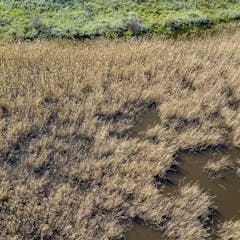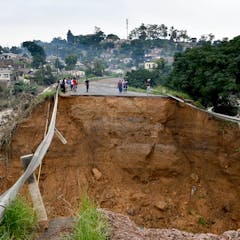
Articles on Flooding
Displaying 1 - 20 of 418 articles

Some parts of the Gulf experienced 18 months of rain in a single day.

Flash floods are getting more common, as warmer air can hold more moisture. But there are other changes leading to more inland flooding on the east coast.

The University of Cape Town’s new report on the impacts of climate change in South Africa found that heatwaves and water stress will affect jobs, deepen inequality, and increase gender-based violence.

Extreme downpours and droughts, both fueled by rising global temperatures, are taking a toll on water infrastructure. Communities trying to manage the threats face three big challenges.

You might be wondering: what is a ‘Black Nor'easter’, what’s causing all this rain and does it have anything to do with climate change? Here’s what you need to know.

Mapping where water once flowed is important for managing flood risk today in Detroit and elsewhere.

Despite improvements in disaster response management since the Abbotsford floods of 2021, long-term animal welfare remains woefully underappreciated in B.C.

Public concerns for real estate value, and a focus on the self, make flood risk maps unpopular. However, these concerns should not dissuade governments from providing resources we can all trust.

Our expert in disaster recovery and climate change adaptation calls for a longer-term response to conflict zones affected by severe flooding, such as Libya and Pakistan.

Climate change is increasing the risks of extreme heat, floods and bushfires, meaning more people are having to consider moving home. But different people come to different decisions.

The strong El Niño that started in 2023 will still have big impacts at least through March. Here’s what to watch for next.

Cyclones and hurricanes are getting more intense. But introducing new categories of storm may not be the answer.

Wetlands can prevent flooding, trap carbon and support livelihoods, as long as they are protected and managed.

The new threat from cyclones can come from behind you – flooding from more intense rainfall.

We crave certainty in our weather forecasts. But that’s only possible for big weather events such as cyclones and major storms. Everything else is probability.

Floodwaters pulsing into the sea normally clear within six days. But the 2022 floods in eastern Australia were different.

Regular floods are washing away parts of KwaZulu-Natal faster than they can be rebuilt.

An atmospheric scientist explains how rising temperatures are helping to fuel extreme storms, floods, droughts and devastating wildfires.

Puddles are an often-ignored but crucial habitat for rare and unusual wildlife.

The North Queensland floods remind us of the need to build community resilience to disasters – during the event, in the immediate aftermath and beyond.





